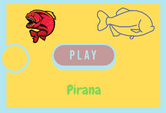Piranha Game Quiz Online
This page features a Piranha Game Quiz Online. It is an exercise for students studying science in 3rd, 4th, 5th, 6th to 8th grades. Students will learn about piranha in this interactive activity. Play this game and learn about it. Remember to learn more by readding the article below.

What Is a Piranha?
It is a fish with a rounded profile and red underside. The head is gray and scaled with silver. The muscles under its high forehead are powerful and the lower jaw is short and stout. It has a triangular row of razor-sharp teeth. Piranhas can bite and shear with incredible force. Its fleshy lips are also thick and hard, which is why it can cause so much damage.
Habitat
Piranha lives in freshwaters in the Amazon basin, Uruguay, Essequibo, and Orinoco rivers of South America. Although piranhas are not native to the United States, some aquariums in the country have introduced them. Although the species can survive in water temperatures as low as 50 degrees Fahrenheit, it is unlikely for it to establish its breeding grounds in these waters. These cold temperatures would make the fish too chilly to survive in freshwaters.
The main purpose of a species tank is to keep several individual piranhas in isolation. In the wild, piranha hunt in packs, so keeping a solitary specimen is not ideal. However, it is possible to breed piranhas and raise thousands of fry. If you breed piranhas, you should use multiple tanks. When breeding, make sure you separate the fry from their parents. Feeding them live food is essential for the fry's survival, as larger piranhas may eat their fry.
Diet
While piranhas do not need highfasttt foods, they do consume fish and small amounts of meat. Greens are a good choice for a piranha's diet because they rot slowly in water, so a small portion of vegetables may be enough for your piranha. Vegetables, however, may not be sufficient, because the piranha may not eat the entire portion.
Attacks on humans
In a recent case, a six-year-old girl died after being beaten by a piranha. The girl and her grandmother had capsized a canoe in a Brazilian river. After rescuing the other children, the grandmother was unable to reach the six-year-old. She called the local authorities and a group of locals helped search the river for her. Despite their best efforts, they were unable to save the girl. The family's lawyer said the piranha attack was likely a tragic mishap and is not an isolated occurrence.
While most piranha attacks are unprovoked, some cases are not reported accurately.
Dentition
Scientists have studied the dentition of piranhas and pacus, which share a common ancestor. They believe these two species evolved a mechanism that replaced all teeth in the same quadrant at once to facilitate chewing on stiff plant materials. This mechanism has a logical explanation: both species replaced all teeth in the same quadrant in order to support grazing. Whether this mechanism evolved to support grazing or for the carnivorous piranha to shear their prey, it is not completely clear.
The Piranha's teeth are very sharp. These teeth are about four millimeters long and are arranged in a triangular interlocking pattern. Their jaw muscles are estimated to make up about two percent of their entire body weight. Their teeth can bite through the flesh of small prey, and a single shake of the head is enough to kill it. Their lower jaw is shark-like, with a sharp underbite.
